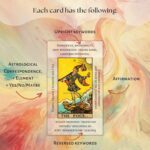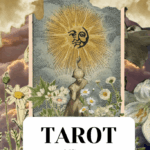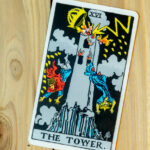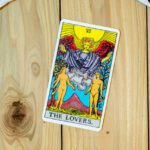The world of tarot has captivated civilizations for centuries. Among its myriad of decks and interpretations, the Major Arcana cards stand out prominently. They serve as crucial symbols laden with profound meaning, invoking intrigue and contemplation. Each card functions as a conduit for introspection, inviting individuals to unravel deeply personal dilemmas while simultaneously reflecting universal truths. This article delves into the fascinating realm of Major Arcana cards, elucidating their meanings, significance, and the psychological underpinnings of their allure.
The Major Arcana encompasses 22 cards, each corresponding to pivotal life experiences and spiritual lessons. These cards are distinct from the Minor Arcana, which typically represents day-to-day events and mundane issues. Instead, the Major Arcana invites individuals to consider their life’s purpose, transformative journeys, and the nature of existence. It is precisely this elevation of meaning that endears the Major Arcana to tarot enthusiasts.
The Fool (0) embodies new beginnings and infinite possibilities. This card encapsulates carefree spontaneity and the leap of faith necessary to embrace the unknown. It signifies both the journey and its inherent uncertainties, urging individuals to embrace naivety and curiosity devoid of reservations. This juxtaposition of freedom and vulnerability presents a dualistic interpretation that resonates with many, symbolizing the innate human desire for growth and exploration.
The Magician (I) stands as a beacon of manifestation, skill, and resourcefulness. This card illustrates the power of will and intention, emphasizing that one possesses all the tools necessary to shape their destiny. The Magician represents the bridge between the conscious and the subconscious, empowering seekers to harness their latent potential. In a world often fraught with feelings of helplessness, this affirmation of personal agency captivates the tarot reader’s imagination.
The High Priestess (II) embodies intuition, secret knowledge, and mystery. This card beckons individuals to look inward and trust their instincts. The High Priestess serves as a reminder of the subconscious mind’s profound influence over perception and experience. Her enigmatic presence can arouse fascination, prompting reflection on the dichotomy between what is known and what remains hidden. These dualities evoke an ever-searching quest for wisdom inherent in the human psyche.
The Empress (III) symbolizes fertility, abundance, and nurturing. Illustrating the nurturing aspects of femininity, this card represents creation, whether through motherhood, artistry, or transformative ideas. The Empress evokes deep-seated instincts linked to vitality and growth, invoking warmth and comfort. It resonates with one’s intrinsic yearning for connection, prosperity, and the cultivation of beauty in life.
The Emperor (IV) complements The Empress through themes of authority, structure, and stability. As the epitome of leadership, The Emperor signifies the importance of establishing order amidst chaos. This card embodies the guardianship required to lay solid foundations in life, whether through personal discipline or the establishment of societal hierarchies. The dual themes presented by The Empress and The Emperor highlight the balance required between nurturing and authority in the pursuit of fulfillment.
The Hierophant (V) introduces the element of tradition, convention, and spiritual guidance. This card connects seekers to established belief systems, urging reflection on cultural wisdom and ethics. The Hierophant’s presence often prompts inquiry regarding societal expectations and conformity, eliciting consideration of personal beliefs in relation to collective ideologies. In a rapidly evolving world, these themes encourage individual exploration while maintaining a link to historical context.
The Lovers (VI) highlights the complexities of relationships, choices, and union. This card symbolizes love and attraction while also underscoring connections laden with moral quandaries. It suggests the importance of alignment and choice in partnerships, offering a potent reminder of the responsibilities entwined with love. The Lovers editorializes on decision-making processes, signifying how one navigates the labyrinth of human connections with profound emotional weight.
The Chariot (VII) represents determination, victory, and willpower. This card illustrates the mastery of opposing forces through discipline and perseverance. It serves as a motivational emblem, urging individuals to harness their strengths to surmount challenges. The Chariot’s dynamic imagery resonates with those experiencing internal or external conflict, captivating the image of triumph over adversity and the indomitable human spirit.
Strength (VIII), both gentle and formidable, signifies courage, resilience, and compassion. This card transcends mere physical prowess, instead illuminating the power of emotional fortitude. Strength compels individuals to confront their vulnerabilities with grace, positing that true power lies in kindness and inner bravery. This paradoxical representation has earned the admiration of many, symbolizing personal evolution through challenges.
The Hermit (IX) invites reflection and solitude, emphasizing the importance of introspection in one’s journey. This card heralds a quest for inner wisdom, catalyzing self-discovery. The Hermit portrays the value of stepping away from external noise to connect with one’s core. In a society often defined by external validation, this archetype resonates deeply with those who seek clarity through solitude.
The Wheel of Fortune (X) encapsulates the cyclical nature of existence, symbolizing the interplay of fate and free will. As life’s seasons shift, this card evokes a sense of inevitability and acceptance. The Wheel serves as a reminder that fortunes can change, urging seekers to embrace both highs and lows with equanimity. Such acknowledgment of life’s impermanence stirs a profound sense of compassion and resilience.
Justice (XI) addresses themes of fairness, truth, and moral integrity. This card serves as a poignant reminder of accountability and the consequences of actions. Justice beckons individuals to confront decisions with clarity, urging a balance between personal desires and ethical imperatives. The quest for justice resonates with the innate human desire for equilibrium in a world rife with chaos.
The Hanged Man (XII) presents a radical change in perspective, advocating the value of surrender and sacrifice. This card encourages individuals to let go of limiting beliefs and embrace the transformative potential of yielding. The Hanged Man’s profundity lies in its ability to teach the significance of patience, humility, and trust in the unfolding of life’s narrative.
Death (XIII) symbolizes transformation, endings, and new beginnings. This card, often misconstrued, invites individuals to accept life’s cyclical nature and the necessity of release. Death heralds profound change and renewal, encapsulating the inevitability of transformation inherent in existence. The acceptance of endings facilitates growth, inextricably linking this card to the universal human experience of transitions.
Temperance (XIV) seeks balance and moderation, representing the alchemical fusion of opposites. This card encourages individuals to cultivate harmony, emphasizing the importance of patience and integration. In a world characterized by extremes, Temperance serves as a clarion call for equilibrium, fostering a pursuit of holistic well-being. The search for balance reverberates throughout human experience, making this card a perennial source of inspiration.
The Devil (XV) confronts addiction, materialism, and unhealthy attachment. This card urges individuals to examine the chains that bind them, addressing the shadows that lurk within the psyche. The Devil reflects humanity’s struggle with temptation and the duality of desire, providing an opportunity for introspection and liberation. Through this confrontation, the prospect for empowerment emerges, highlighting the path to emotional and spiritual emancipation.
The Tower (XVI) symbolizes upheaval, revelation, and the dismantling of falsehoods. Although daunting, The Tower signifies the cathartic experience of tearing down illusions to reveal unvarnished truth. This card highlights the serendipitous nature of chaos and transformation. Though tumultuous, the dismantling instigates growth and deeper insight into one’s self.
The Star (XVII) shines forth with hope, inspiration, and serenity. This card denotes a beacon of light amidst adversity, encouraging individuals to dream openly and act with optimism. The Star serves as a reminder of the expansive possibilities that await, nurturing a profound belief in the universe’s benevolence. Through reminders of connection to the divine, this card speaks to the human tendency to yearn for transcendence.
The Moon (XVIII) delves into the realm of illusion, intuition, and subconscious fears. This card inspires exploration into the dark recesses of the mind, asserting that understanding lies beyond the surface. The Moon beckons to confront fear and doubt while navigating the metaphysical landscape of emotions. Its mysterious aura invokes an insatiable curiosity about the unseen and the ineffable.
The Sun (XIX) embodies joy, success, and vitality. This card radiates positivity, illuminating the essence of life’s accomplishment and creative fervor. The Sun celebrates renewal and growth, showcasing the vibrant energy of youthful exuberance. Its infectious warmth invites seekers to revel in the beauty of existence and bask in moments of clarity and triumph.
Judgment (XX) signifies renewal, redemption, and epiphany. This card calls for self-reflection and assessment, urging individuals to examine their past actions and align with their higher selves. Judgment prompts reconciliation between past and present, delivering a transformative understanding of one’s purpose within the broader narrative of life. The emergence of self-evaluation evokes a potent desire for personal accountability and growth.
The World (XXI) encapsulates completion, fulfillment, and unity. This card signifies the successful conclusion of a cycle, representing personal achievements and the integration of experiences. The World embodies a sense of wholeness, symbolizing the interconnectedness of all things. This final card invites individuals to celebrate their journey, recognizing the rich tapestry of life interwoven with lessons and aspirations.
Ultimately, Major Arcana tarot cards delve deep into the human condition, mirroring universal themes that span across time and cultures. Their potent symbolism and layered meanings resonate within the psyche, unveiling insights into individual journeys while posing far-reaching questions about existence itself. This multifaceted relationship between the cosmos and the self fosters an enduring fascination with the tarot, offering seekers a path toward enlightenment, understanding, and ultimately, self-realization.










Leave a Comment